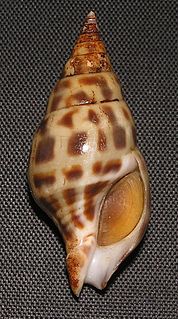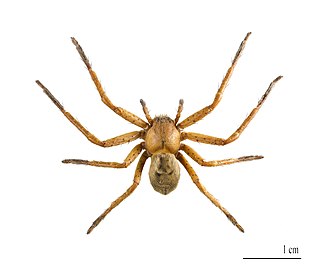
Huntsman spiders, members of the family Sparassidae, are known by this name because of their speed and mode of hunting. They are also called giant crab spiders because of their size and appearance. Larger species sometimes are referred to as wood spiders, because of their preference for woody places. In southern Africa the genus Palystes are known as rain spiders or lizard-eating spiders. Commonly they are confused with baboon spiders from the Mygalomorphae infraorder, which are not closely related.
Olios lepidus is a species of huntsman spider, found in Brazil.
Pusionella lupinus is a species of sea snail, a marine gastropod mollusk in the family Clavatulidae.

Pusionella is a genus of sea snails, marine gastropod mollusks in the family Clavatulidae.
Indosylvirana milleti is a species of true frog. Originally described in the genus Rana, then Hylarana and Indosylvirana, it may now be placed in Papurana. It is native to Cambodia, China (Yunnan), Thailand, Vietnam, and quite possibly Laos. It is a locally common frog found by ponds and streams in seasonal tropical forests.

Chintamoni Kar Bird Sanctuary (CKBS) situated at south Kolkata and near Narendrapur Ramkrishna Mission. This is also known as Kayal-r Bagan. This garden is famous for availability of wide variety of birds, butterflies, ferns and orchids.

Olios argelasius is a species of huntsman spider found in the Mediterranean Basin. It was first described by Charles Athanase Walckenaer in 1805.

Olios is the largest genus of huntsman spiders, containing 250 species. They are found throughout the world, with most species occurring in hot countries. The genus was first described by Charles Athanase Walckenaer in 1837.
Plesiophrictus is a genus of tarantulas that was first described by Reginald Innes Pocock in 1899.
Olios ceylonicus is a species of spider of the genus Olios. It is endemic to Sri Lanka. It is part of the huntsman spider family Sparassidae.
Olios greeni, is a species of spider of the genus Olios. It is endemic to Sri Lanka.
Olios hirtus, is a species of spider of the genus Olios. It is endemic to Sri Lanka.

Olios lamarcki, is a species of spider of the genus Olios. It is found in Madagascar to Sri Lanka and India. The subspecies O. lamarcki taprobanicus is endemic to Sri Lanka.
Olios senilis, is a species of spider of the genus Olios. It is native to India and Sri Lanka.
Heterophrictus is a genus of Indian tarantulas that was first described by Reginald Innes Pocock in 1900.

Curicaberis is a genus of huntsman spiders that was first described by C. A. Rheims in 2015.

Olios giganteus is a species of giant crab spider in the family Sparassidae. It is found in the United States and Mexico.








